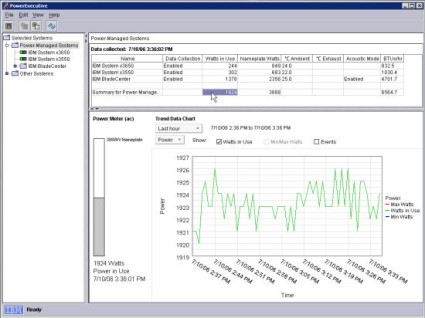AMD and IBM try next-gen power saving architecture for 'System x' servers
New York (NY) - In an elaborate unveiling ceremony featuring no less than the Red Bull Formula 1 racing team, senior executives from IBM and AMD, including AMD CEO Hector Ruiz, introduced a new line of IBM xSeries blade servers - now re-christened "IBM System x" - that promises to slash operations and maintenance costs through the creative use of Opteron processors.
While Formula 1 machines are generally known more for their power consumption, the two executive teams were busy today touting what IBM is actively calling a "green computing" scheme using "Cool Blue" architecture. With the performance of CPUs such as Opteron now exceeding the physical limits of their own substrates, given no cooling whatsoever, managing a bank of modern servers has become a process akin to monitoring a nuclear reactor. Even when the systems do work properly, everyday maintenance can still be problematic. For instance, is the collected power of certain adjacent blades exceeding the amount budgeted? And is the exhaust temperature of the cooling system rising beyond prescribed tolerances simply to keep the blades comfortable?
A screenshot of IBM's PowerExecutive software in action. Here, administrators can remotely monitor their servers' physical climate data from anywhere in the world. Using software akin to the management console (MMC) in Windows Server, admins can actually simulate what happens if problems get worse, simulate potential load-balancing solutions, and implement those changes on the fly. (Courtesy IBM)
So while it's nice that the latest IBM System x servers have upgraded AMD Opteron processors (more on that in a moment), much of the emphasis of today's gala unveiling today was on cooling. With the new maintenance platform IBM announced today, servers are geared with a network of environmental sensors. Like a NASA mosaic photograph of the surface of Mars, the sensors' combined data gives IBM software, called PowerExecutive, a live weather report for the entire system, including airflow and thermal dynamics. When a problem crops up, PowerExecutive will, according to IBM, construct a mathematical model of the likely cause, using simulator data as a model - a sort of "future-cast" for your servers. Then using the same basic concepts as servers have already used for load balancing for optimizing performance, the administrator is given options to redistribute workloads to compensate, quite literally, for the changing climate.
As if to underscore IBM's point with a little natural poignancy, Mother
Nature herself added some spooky ambiance to today's rollout event. A record heat wave throughout New York City was to blame for rolling power outages which, while it affected neighborhoods in Queens, did not affect the power levels in the convention hall. It did affect the mood, however, including when executives stood outside the venue to pose with the new System x and the Red Bull car, in the sweltering heat.
Of the three System x models premiered today, the premium x3755 is the one to watch. Although this server can be fitted with four Opterons working in tandem, IBM actually admits that customers will be better off with just three. The reason is a CPU pass-through card that enables the Opterons to better distribute the workload, so that three CPUs can outperform four in nominal situations. The x3455, meanwhile, squeezes as much of the new features as it can into a 1U rack-mount chassis.
Get Tom's Hardware's best news and in-depth reviews, straight to your inbox.
Today, IBM is touting a memory advance over and above AMD's HyperTransport bus. It's calling this "Xcelerated Memory Technology" (with a capital "X"), and promising 15% better throughput than with existing xSeries servers. TG Daily has asked IBM to explain this technology in further detail, and we've been told an engineer will be made available to us.

